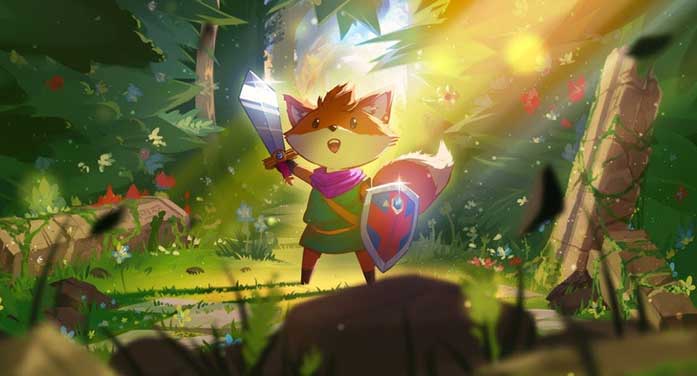Warning: this article contains some thematic and story spoilers for Tunic. Though such spoilers are kept to a minimum, your expectations and the discoveries you make while playing are a big part of what makes Tunic special. You may want to enter the experience with as little knowledge as possible.

Tunic is an old-school adventure about saving the land from evil. You’re an adorable little fox person, running around a colourful, bright world. You take on baddies, brave underground passages and uncover magical treasure.
And you’re being lied to.
Something feels off. Beyond the veil of soft sunshine, there’s a dark mystery. At the core of this world, swaddled deep within the pleasant folds of nostalgia, something rots.
You’re dropped into the world of Tunic with no information, albeit a bit of expositional lore. From there, you’re fed information piecemeal, but it’s often less than helpful.
An inscrutable language adorns signposts, leaving you uncertain and directionless. Enemies roam nearby, yet you have nothing to defend yourself with. The only option is to move forward.
You begin gathering pages that contain information or clues. Before long, you realize these pages come together to form … a video game manual? For the game you’re playing?
With very little to guide you except a few hints gleaned from the manual (which is largely written in the unknown language), your only option is to explore. In fact, primarily, that’s what Tunic is all about: exploration and discovery. And it excels at it.
Tunic is a beautiful, rare gem of a game. It both derives from and actively subverts a sub-genre of games spawned from The Legend of Zelda series. Zelda seeps through the pores of Tunic, especially the 90’s-era entries.
Slightly gross analogy aside, it was almost impossible for me to forget the Zelda games in the opening hours of Tunic. This isn’t a criticism; It’s necessary to set up the revelations and discoveries to come, baiting you into a sense of familiarity.
At its core, Tunic is an adventure game. Combat does play a significant role, but the meat of the game lies in its world design and mysteries. If I had to give one piece of advice to new players, I’d say: “Go everywhere, try everything.”
Is that two pieces of advice? Maybe. Let’s move on.
The world is open and yours to explore from the start, excluding a few paths that require you to have something special. You’ll see many things just out of reach and you must puzzle out how to access them. Telescopes dot the environment, giving you a wide view of your surrounding landscape, which is necessary for gathering information.
A lot of Tunic is about understanding your environment and slowly unravelling the interconnectedness of everything. Without seeing a clear path, I would start moving in any direction to see what I found. I eventually would pop up on the other side of a gap that I previously couldn’t figure out how to breach and open up a shortcut back to the beginning.
The game encourages you to poke around everywhere. If there’s a small nook you think you could fit in, try it. Is there a corner that appears to lead to nothing? Check anyway. There are ways to shift your perspective just a little that will lead you to surprising things.
Aside from the language, there are other unknowable symbols and patterns throughout Tunic’s forests, mountains and caves that will mean next to nothing in the beginning. But don’t lose faith; Tunic’s secrets slowly reveal themselves if you’re paying attention. And even if you’re not paying attention, sometimes you’ll be slapped in the face with an answer. Both are good.
Though certainly not the standout, combat is serviceable and fun. Holding a sword and shield – only one of which can be active at any given time – and with a dodge-roll ability in your arsenal, fights are a risk-reward affair. Timing the right moments to guard, dodge or attack requires observation and patience. Sometimes.
Tunic’s combat was at its best when it required this focus. But after encountering each enemy type several times, I mostly just wanted to get past them. Especially late-game, when you’re venturing back through the same locations to find a mysterious something, but you have to wade through the same handful of goons again.
However, the combat shines in boss battles. These are epic, intimidating confrontations that demand your attention. Proper use of the shield is essential, but it’s even more integral to master the dodge-roll. You’re invincible for the first few frames of the roll, so understanding each boss’s ‘tells’ and being able to predict their moves is a must.
If I had one complaint about the boss encounters, it would be that there aren’t enough, though I admit that adding more of these fights would have felt forced. Narratively, the number of Big Bads you come across makes sense. It’s just too bad that these fights are so few, as they’re the only time I felt engaged and rewarded by combat.
After I finished Tunic, I began a New Game +, wherein you start from the beginning but with many of the upgrades and items you had by the end of the game. Having these upgrades from the start certainly made Tunic easier, but the real fun of a New Game + is having a vastly different understanding of the world than I did on my first play-through. I could go places right away that I once mistook for inaccessible, simply because I now knew a secret path.
Some things I realized I’d had access to from the opening minutes, but I was missing a piece of information. No special item, no ability required, simply knowledge. Alternate, more efficient routes presented themselves. This was a world that I understood, that I had some control over, very unlike my first tentative steps forward.
Perhaps what I find most fascinating about Tunic, and games that similarly evoke a sense of mystery and wonder, are the fervent communities they spawn. The unknown language, impossible to decipher at first, has been tackled and deduced by hardworking, fascinated fans. Little pieces of environmental world-building are discovered and speculated on. Hidden collectables and locations are hinted at. It’s a concentration of enthusiasm that’s thrilling to be a part of. I truly think that gaming is at its best when it provokes a gathering of shared love and discovery like Tunic does.
Tunic’s mysteries pull at you, even when you’re not playing. More than once I found myself brushing my teeth at night, contemplating this door or that inscription. My time with it was some of the most engaged gaming I’ve done in a long time.
Tunic is an easy recommendation for me, and I encourage anyone who is at all interested in spending some time with this brave little fox person to go and make some discoveries.
Sam Stewart is a writer and performer, having worked professionally in theatre and film. He also works in the tech industry and loves to indulge his lifelong passion for video games, from the classics to new releases.
The opinions expressed by our columnists and contributors are theirs alone and do not inherently or expressly reflect the views of our publication.
© Troy Media
Troy Media is an editorial content provider to media outlets and its own hosted community news outlets across Canada.


